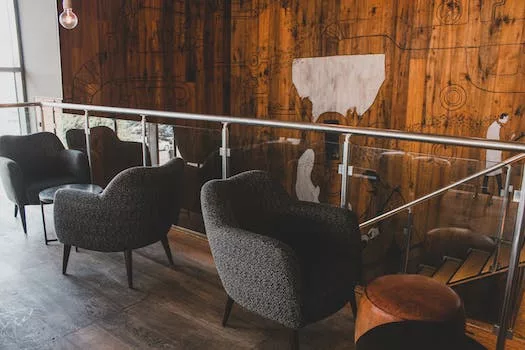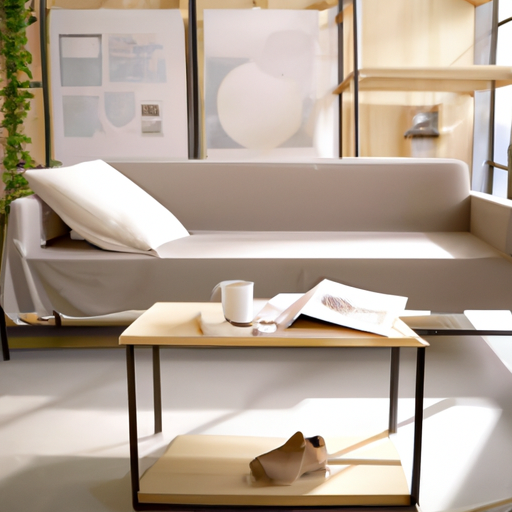Maximizing Space and Functionality for a Productive Home Office
In today’s fast-paced world, the concept of a home office has become increasingly popular as more and more people are opting to work from home. Whether you are a freelancer, a remote worker, or an entrepreneur, having a dedicated workspace in your home is essential for productivity and success. Designing a home that is perfect for a home office requires careful planning and consideration of various factors, including maximizing space and functionality. This article will provide you with valuable insights on how to create a productive home office that caters to your specific needs and preferences.
One of the most critical aspects of designing a home office is ensuring that you have enough space to work comfortably and efficiently. This means that you need to allocate a specific area in your home that will serve as your office. Ideally, this space should be separate from your living and sleeping areas to minimize distractions and maintain a healthy work-life balance. If you have limited space, consider converting a spare bedroom, a corner of your living room, or even a closet into a functional workspace.
Once you have identified the perfect spot for your home office, it is essential to maximize the available space to create a comfortable and efficient working environment. Start by decluttering the area and removing any unnecessary items that may hinder your productivity. This will not only create more room for your office essentials but also help you maintain a clean and organized workspace.
Next, consider the layout of your home office. The placement of your desk, chair, and other office equipment should be well-thought-out to ensure that you can move around freely and access everything you need with ease. Make sure that your desk is positioned in a way that allows for ample natural light, as this can significantly impact your mood and productivity. If natural light is limited, invest in good-quality artificial lighting that mimics daylight to create a bright and inviting workspace.
In addition to the layout, the choice of furniture plays a crucial role in maximizing space and functionality in your home office. Opt for ergonomic furniture that provides adequate support and comfort, as this can help prevent work-related injuries and improve your overall well-being. When selecting a desk, consider one with built-in storage solutions such as drawers and shelves to keep your workspace organized and clutter-free. Similarly, choose a chair with adjustable features to ensure that it can be customized to suit your body type and preferences.
Another essential aspect of designing a home office is incorporating technology that enhances productivity and efficiency. Invest in reliable and high-speed internet connectivity, as this will enable you to work seamlessly and stay connected with your clients and colleagues. Additionally, consider installing smart devices such as voice-activated assistants and automated lighting systems to streamline your daily tasks and create a more efficient workspace.
Lastly, personalizing your home office can significantly impact your motivation and productivity levels. Incorporate elements that reflect your personality and preferences, such as artwork, plants, and decorative items. However, be mindful not to overcrowd your workspace with too many personal items, as this can create distractions and hinder your ability to focus.
In conclusion, designing a home that is perfect for a home office requires careful planning and consideration of various factors, including space allocation, layout, furniture selection, technology integration, and personalization. By following the tips and insights provided in this article, you can create a productive and efficient workspace that caters to your specific needs and preferences, ultimately contributing to your success as a remote worker or entrepreneur.
Integrating Comfort and Style in Your Home Office Design

In today’s fast-paced world, the concept of a home office has become increasingly popular as more and more people are opting to work from home. Whether you are a freelancer, a remote worker, or an entrepreneur, having a dedicated workspace in your home is essential for productivity and success. Designing a home that is perfect for a home office requires a careful balance of comfort and style, ensuring that your workspace is both functional and aesthetically pleasing. This article will provide you with valuable insights on how to integrate comfort and style in your home office design.
To begin with, it is crucial to select the right location for your home office. Ideally, the space should be separate from the rest of your living areas, allowing you to maintain a clear distinction between your work and personal life. This separation will help you stay focused and minimize distractions while working. Additionally, consider factors such as natural light, ventilation, and noise levels when choosing the location. A well-lit, airy, and quiet space will not only enhance your productivity but also contribute to your overall well-being.
Once you have identified the perfect spot for your home office, it is time to focus on the layout and furniture. The key to a comfortable and stylish home office is to invest in ergonomic furniture that supports your body and promotes good posture. An adjustable chair with proper lumbar support, a spacious desk with ample storage, and a monitor stand to maintain eye level are some of the essential elements to consider. Moreover, incorporating adjustable and modular furniture will allow you to customize your workspace according to your needs and preferences, ensuring maximum comfort and functionality.
Incorporating your personal style into your home office design is equally important. Your workspace should be a reflection of your personality and taste, making it a space where you feel inspired and motivated. To achieve this, consider incorporating elements such as artwork, decorative accessories, and color schemes that resonate with you. For instance, you can choose a color palette that is both soothing and energizing, such as soft blues, greens, or neutrals. Alternatively, you can opt for bolder colors and patterns if that aligns with your personal style. The key is to create a harmonious balance between comfort and aesthetics, ensuring that your home office is a space where you enjoy spending time.
Lighting is another crucial aspect of designing a comfortable and stylish home office. Adequate lighting not only reduces eye strain and fatigue but also sets the mood and ambiance of the space. To achieve optimal lighting, consider incorporating a combination of natural light, ambient lighting, and task lighting. Large windows, skylights, or glass doors can help maximize natural light, while floor lamps, table lamps, and pendant lights can provide ambient and task lighting. Additionally, consider using LED bulbs and dimmer switches to adjust the brightness and color temperature according to your needs and preferences.
Finally, do not overlook the importance of organization and storage in your home office design. A clutter-free and well-organized workspace not only enhances productivity but also contributes to the overall aesthetics of the space. Invest in functional storage solutions such as shelves, cabinets, and filing systems to keep your documents, stationery, and equipment organized and easily accessible. Moreover, incorporating stylish storage options such as decorative baskets, boxes, and trays can help maintain a cohesive and visually appealing workspace.
In conclusion, designing a home that is perfect for a home office requires a thoughtful integration of comfort and style. By carefully considering factors such as location, furniture, personal style, lighting, and organization, you can create a functional and aesthetically pleasing workspace that supports your productivity and well-being.
Balancing Work-Life Boundaries with a Well-Designed Home Office
Designing a home that is perfect for a home office requires careful planning and consideration of various factors. The goal is to create a space that fosters productivity and efficiency while maintaining a healthy work-life balance. This article will discuss some essential tips and strategies for designing a home that is conducive to a home office setup.
One of the most critical aspects of designing a home office is selecting the right location. Ideally, the office should be situated in a quiet area of the house, away from distractions and noise. This will help you maintain focus and concentration during work hours. If possible, choose a room with a door that can be closed to create a physical barrier between your work and personal life. This separation is crucial for maintaining a healthy work-life balance and preventing burnout.
Another essential factor to consider is the layout and design of the home office. The space should be functional and comfortable, with ample room for a desk, chair, and any necessary equipment or storage. Ergonomics should be a top priority, as spending long hours at a poorly designed workstation can lead to physical discomfort and strain. Invest in a high-quality chair with proper lumbar support and adjustability, and position your computer monitor at eye level to reduce neck strain. Additionally, ensure that your desk is at a comfortable height and provides enough space for your legs and knees.
Lighting is another crucial element in designing a home office. Natural light is ideal, as it has been proven to boost mood, productivity, and overall well-being. If possible, position your desk near a window to take advantage of natural light during the day. However, it’s also essential to have adequate artificial lighting for those times when natural light is insufficient or unavailable. Opt for adjustable task lighting that can be directed where needed, and consider using LED bulbs, which are energy-efficient and provide a more natural light quality.
In addition to the physical aspects of the home office, it’s essential to consider the psychological factors that can impact your productivity and well-being. One way to create a positive work environment is by incorporating elements of biophilic design, which focuses on the connection between humans and nature. This can be achieved by incorporating plants, natural materials, and nature-inspired artwork into your home office design. Studies have shown that exposure to natural elements can reduce stress, improve cognitive function, and enhance mood.
Another psychological factor to consider is the color scheme of your home office. Colors can have a significant impact on mood and productivity, so it’s essential to choose a palette that promotes focus and concentration. Cool colors, such as blues and greens, are known to have a calming effect and can help create a more focused work environment. On the other hand, warm colors, such as reds and oranges, can stimulate creativity and energy. Ultimately, the choice of color will depend on your personal preferences and the type of work you do.
Finally, it’s essential to establish boundaries and routines that help maintain a healthy work-life balance. This can include setting specific work hours, taking regular breaks, and creating rituals that signal the beginning and end of the workday. By establishing these routines and boundaries, you can ensure that your home office remains a productive and efficient space while still allowing you to enjoy the benefits of working from home.
In conclusion, designing a home that is perfect for a home office involves careful consideration of location, layout, ergonomics, lighting, and psychological factors. By taking the time to plan and design a space that meets your needs and promotes productivity, you can successfully balance work-life boundaries and enjoy the benefits of working from home.
Q&A
Question 1: What are the essential elements to consider when designing a home office?
Answer: The essential elements to consider when designing a home office are a dedicated workspace, proper lighting, ergonomic furniture, storage solutions, and noise reduction.
Question 2: How can one create an efficient and productive home office layout?
Answer: To create an efficient and productive home office layout, allocate a specific area for the workspace, ensure easy access to power outlets, arrange furniture to maximize functionality, and consider incorporating elements like standing desks or adjustable chairs for comfort.
Question 3: What are some tips for incorporating a home office into a small living space?
Answer: To incorporate a home office into a small living space, consider utilizing vertical space for storage, using multi-functional furniture, creating a designated workspace within a larger room, and using visual dividers like shelves or curtains to separate the office area from the rest of the living space.
Conclusion
In conclusion, designing a perfect home office requires careful planning and consideration of factors such as location, layout, lighting, ergonomics, storage, and technology integration. By prioritizing functionality, comfort, and productivity, one can create a dedicated workspace that fosters efficiency and well-being, ultimately enhancing the work-from-home experience.


